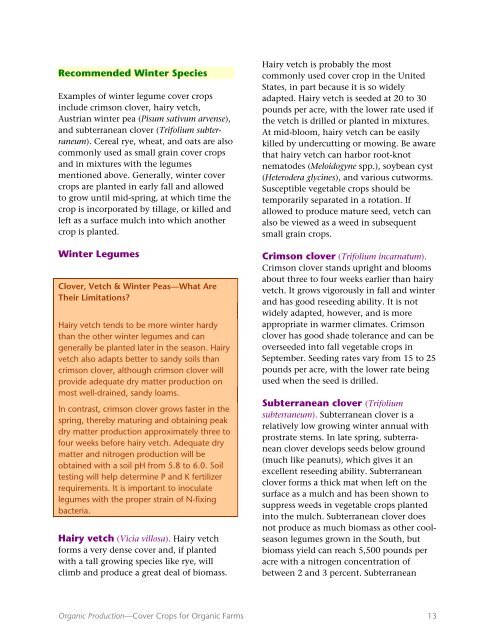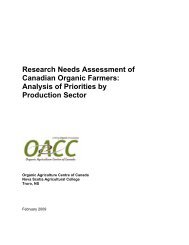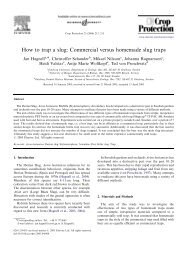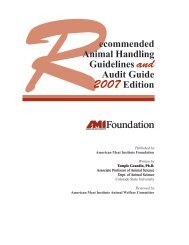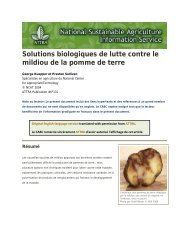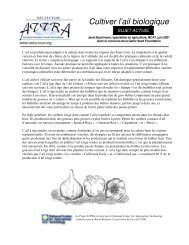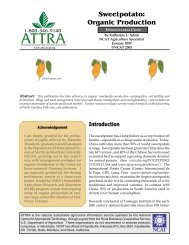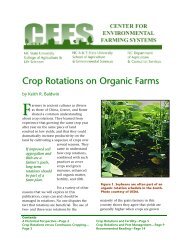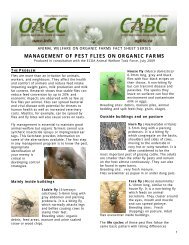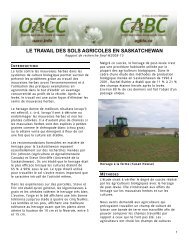Create successful ePaper yourself
Turn your PDF publications into a flip-book with our unique Google optimized e-Paper software.
Recommended Winter SpeciesExamples of winter legume cover cropsinclude crimson clover, hairy vetch,Austrian winter pea (Pisum sativum arvense),and subterranean clover (Trifolium subterraneum).Cereal rye, wheat, and oats are alsocommonly used as small grain cover cropsand in mixtures with the legumesmentioned above. Generally, winter covercrops are planted in early fall and allowedto grow until mid-spring, at which time thecrop is incorporated by tillage, or killed andleft as a surface mulch into which anothercrop is planted.Winter LegumesClover, Vetch & Winter Peas—What AreTheir Limitations?Hairy vetch tends to be more winter hardythan the other winter legumes and cangenerally be planted later in the season. Hairyvetch also adapts better to sandy soils thancrimson clover, although crimson clover willprovide adequate dry matter production onmost well-drained, sandy loams.In contrast, crimson clover grows faster in thespring, thereby maturing and obtaining peakdry matter production approximately three tofour weeks be<strong>for</strong>e hairy vetch. Adequate drymatter and nitrogen production will beobtained with a soil pH from 5.8 to 6.0. Soiltesting will help determine P and K fertilizerrequirements. It is important to inoculatelegumes with the proper strain of N-fixingbacteria.Hairy vetch (Vicia villosa). Hairy vetch<strong>for</strong>ms a very dense cover and, if plantedwith a tall growing species like rye, willclimb and produce a great deal of biomass.Hairy vetch is probably the mostcommonly used cover crop in the UnitedStates, in part because it is so widelyadapted. Hairy vetch is seeded at 20 to 30pounds per acre, with the lower rate used ifthe vetch is drilled or planted in mixtures.At mid-bloom, hairy vetch can be easilykilled by undercutting or mowing. Be awarethat hairy vetch can harbor root-knotnematodes (Meloidogyne spp.), soybean cyst(Heterodera glycines), and various cutworms.Susceptible vegetable crops should betemporarily separated in a rotation. Ifallowed to produce mature seed, vetch canalso be viewed as a weed in subsequentsmall grain crops.Crimson clover (Trifolium incarnatum).Crimson clover stands upright and bloomsabout three to four weeks earlier than hairyvetch. It grows vigorously in fall and winterand has good reseeding ability. It is notwidely adapted, however, and is moreappropriate in warmer climates. Crimsonclover has good shade tolerance and can beoverseeded into fall vegetable crops inSeptember. Seeding rates vary from 15 to 25pounds per acre, with the lower rate beingused when the seed is drilled.Subterranean clover (Trifoliumsubterraneum). Subterranean clover is arelatively low growing winter annual withprostrate stems. In late spring, subterraneanclover develops seeds below ground(much like peanuts), which gives it anexcellent reseeding ability. Subterraneanclover <strong>for</strong>ms a thick mat when left on thesurface as a mulch and has been shown tosuppress weeds in vegetable crops plantedinto the mulch. Subterranean clover doesnot produce as much biomass as other coolseasonlegumes grown in the South, butbiomass yield can reach 5,500 pounds peracre with a nitrogen concentration ofbetween 2 and 3 percent. Subterranean<strong>Organic</strong> Production—<strong>Cover</strong> <strong>Crops</strong> <strong>for</strong> <strong>Organic</strong> <strong>Farms</strong> 13


